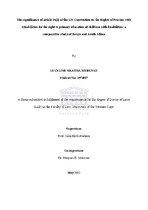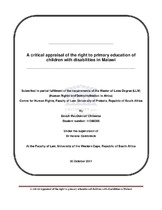| dc.description.abstract | The UN Convention on the Rights of Persons with Disabilities (CRPD) is the latest human rights treaty at the UN level. The process leading to the adoption called attention to the plight of persons with disabilities, and redefined approaches to issues of disability. Fundamentally, the CRPD embodies a paradigm shift in thinking about disability. It embraces the social model of disability, in terms of which disability is a function of the interaction between a person with impairment and his or her environment as opposed to an inherent limitation of functioning. The social model is, in turn, anchored in a human rights approach to disability. No doubt, the adoption of the CRPD triggered immense optimism for the realization of the rights of persons with disabilities. One of the rights recognised under the CRPD is the right to education. Article 24(1) of the CRPD recognises the right of persons with disabilities to education and sets out the aims of such education. Article 24(2) sets out a number of principles to guide the implementation of the right. These include: non-exclusion from the general education system including non-exclusion of children with disabilities from free and compulsory primary education; access to inclusive quality and free primary education on an equal basis with other children in the communities in which children with disabilities live; reasonable accommodation of a student’s needs; provision of support necessary to facilitate effective education; and provision of individualised support measures in environments that maximise academic and social development of the students with disabilities. It is generally accepted that the right to education is one of the most essential rights, particularly in light of its empowerment function that helps to facilitate the exercise of other rights. The primary level of education has particularly attained global recognition and priority in resource allocation and implementation. Primary education contributes significantly to the maximum development of the full human potential of children. There are therefore differentiated obligations for the right to primary education in international human rights. Nevertheless, there are still significant barriers to access to primary education, particularly in the African region. While children with disabilities have been excluded from education for a long time the world over, their exclusion in the African context is particularly endemic. The core purpose of this thesis is to determine how article 24(2) of the CRPD affects or is likely to affect primary education of children with disabilities, particularly in the context of developing countries. The focus of the enquiry is mainly the law and policy in this regard. The subject spans three main spheres of rights: children’s rights, socioeconomic rights (particularly the right to education), and finally disability rights. Children’s rights, especially since the adoption of the Convention on the Rights of the Child (CRC), are generally accepted. The right to education also has a long standing history, and whereas debate regarding the appropriate approaches to its implementation still abides, there is apparent normative and jurisprudential consensus on some aspects thereof, particularly at the primary education level. It is essential to determine the relational framework of these spheres with the disability rights established under the CRPD. The thesis finds that the CRPD does in fact redefine the parameters of the right to education as previously understood in international human rights instruments. Particularly, the expanded aims of education under article 24 call for education systems that recognise non-academic learning, such as the development of the talents or creativity of the learner. This provision is particularly significant to the child with disabilities. Also, while not establishing an entirely new right, the principles under article 24(2) establish actionable sub-entitlements that enhance the justiciability right to education for children with disabilities. However, it is apparent from the comparative studies that it is the implementation of these provisions that presents the greatest challenge for the realisation of primary education for children with disabilities. This suggests that whereas norm creation as under the CRPD may have the value of triggering and sustaining discourse on appropriate responses in the context of the education of children with disabilities, it is the translation of these norms into practical action points that is the determining factor for realization of the right. | en_US |




